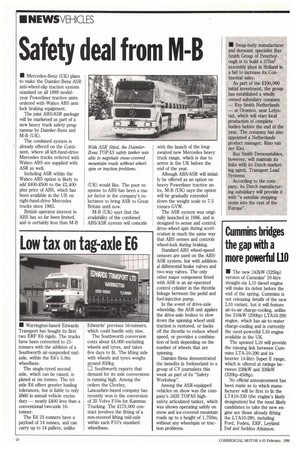Safety deal from Mil
Page 12

If you've noticed an error in this article please click here to report it so we can fix it.
• Mercedes-Benz (UK) plans to make the Daimler-Benz ASR anti-wheel-slip traction system standard on all 1989 modelyear Powerliner tractive units ordered with Wabco ABS antilock braking equipment.
The joint ABS/ASR package will be marketed as part of a new heavy truck safety programme by Daimler-Benz and M-B (UK).
The combined system is already offered on the Continent, where all left-hand-drive Mercedes trucks ordered with Wabco ABS are supplied with ASR as well.
Including ASR within the Wabco ABS option is likely to add 2400-2500 to the £2,400plus price of ABS, which has been available in the UK on right-hand-drive Mercedes trucks since 1983.
British operator interest in ABS has so far been limited, and is certainly less than M-B (UK) would like. The poor response to ABS has been a major factor in the company's reluctance to bring ASR to Great Britain until now.
M-B (UK) says that the availability of the combined ABS/ASR system will coincide with the launch of the longawaited new Mercedes heavy truck range, which is due to arrive in the UK before the end of the year.
Alltough ABS/ASR will initially be offered as an option on heavy Powerliner tractive units, M-B (UK) says the option will be gradually extended down the weight scale to 7.5 tonnes GVW.
The ASR system was originally launched in 1986, and is designed to sense and control, drive-wheel spin during acceleration in much the same way that ABS senses and controls wheel-lock during braking.
Standard ABS wheel-speed sensors are used on the ABS/ ASR system, but with additional differential brake valves and two-way valves. The only other major component fitted with ASR is an air-operated control cylinder in the throttle linkage between the pedal and fuel-injection pump.
In the event of drive-axle wheelslip, the ASR unit applies the drive-aide brakes to slow down the spinning wheel until traction is restored, or backs off the throttle to reduce wheel speed, or provides a combination of both depending on the number of wheels that are spinning.
Daimler-Benz demonstrated the benefits in Switzerland to a group of CV journalists this week as part of its "Safety Workshop".
Among the ASR-equipped vehicles on show was the company's 1635 TOPAS highsafety articulated tanker, which was shown operating safely on snow and ice-covered mountain roads up to a height of 1,750m, without any wheelspin or traction problems.




















































































